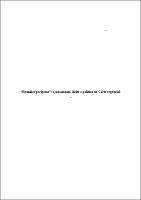Please use this identifier to cite or link to this item:
https://rima.ufrrj.br/jspui/handle/20.500.14407/13886| Tipo do documento: | Dissertação |
| Title: | "Reuniões perigosas": ajuntamento ilícito e política na Corte regencial (1831 - 1837) |
| Other Titles: | "Dangerous gatherings": illicit gatherings and politics in the regency Court (1831 - 1837) |
| Authors: | Santana, Katia Luciene de Oliveira e Silva |
| Orientador(a): | Basile, Marcello Otávio Neri de Campos |
| Primeiro membro da banca: | Basile, Marcello Otávio Neri de Campos |
| Segundo membro da banca: | Martins, Monica de Souza Nunes |
| Terceiro membro da banca: | Fonseca, Marcos Luiz Bretas da |
| Keywords: | Ajuntamento ilícito;Regência;Cidade-Corte;Civilização e disciplina;Illicit gathering;Regency;Court-City;civilization and discipline |
| Área(s) do CNPq: | História |
| Idioma: | por |
| Issue Date: | 16-Apr-2019 |
| Publisher: | Universidade Federal Rural do Rio de Janeiro |
| Sigla da instituição: | UFRRJ |
| Departamento: | Instituto de Ciências Humanas e Sociais |
| Programa: | Programa de Pós-Graduação em História |
| Citation: | SANTANA, Katia Luciene de Oliveira e Silva. "Reuniões perigosas": ajuntamento ilícito e política na Corte regencial (1831 - 1837). 2019. 193 f.. Dissertação(Mestrado em História) - Instituto de Ciências Humanas e Sociais, Universidade Federal Rural do Rio de Janeiro, Seropédica, RJ, 2019. |
| Abstract: | No intenso período regencial, as disputas políticas e as questões sociais imbricaram-se, transformando os espaços da cidade-Corte do Rio de Janeiro em local de conflitos. A instabilidade institucional e os distúrbios urbanos impuseram às autoridades regenciais à frente do governo da nação, o desafio de manter a ordem na capital do Império. Doravante, o aparato repressivo do Estado contou com uma polícia judicial que além de combater os delitos passou a atuar de maneira preventiva sobre as condutas indisciplinadas, consideradas incivilizadas, desordeiras e suspeitas. Nesse sentido, os ajuntamentos foram tratados como ações potencialmente criminosas. Este trabalho tem como objeto central o ajuntamento ilícito, suas representações no contexto sociopolítico nos anos de 1831 a 1837, ou seja, entre o fim turbulento do Primeiro Reinado e a ascensão do Regresso conservador. Buscou-se, portanto, investigar e identificar ― a partir da análise dos registros criminais localizados no Arquivo Nacional do Rio de Janeiro ―, em que circunstâncias reuniões entre três ou mais indivíduos foram tratadas, ou efetivamente enquadradas como ilícitas, considerando os novos códigos legais e as motivações políticas sobre a “questão social”, em uma cidade marcada pela lógica da escravidão urbana. Por fim, são analisadas as formas como os atores sociais interagem à aplicação das normas legais sobre suas condutas e ações coletivas |
| Abstract: | During the intense regency period, the political disputes and the social issues were integrated transforming the spaces of the Court-city of Rio de Janeiro into a place of conflicts. The institutional instability and the urban disturbs imposed to the regency authorities in charge of ruling the nation, the challenge of keeping the order in the Empire’s capital. Hereafter, the repressive apparatus of the State used a legal police service that besides combating the criminal offences, started to act in a more preventive way towards harmful behavior, considered uncivilized, troublesome and suspect. In this sense, gatherings of people were treated as potentially criminal actions. This research has as its main object the illicit gathering, its representations in the sociopolitical context from 1831 to 1837, more precisely, between the turbulent end of the First Reign and the growth of the conservative return. The purpose, therefore, is to investigate and identify – considering the analysis of the criminal files located at the National Archives of Rio de Janeiro –, in which circumstances, gatherings among three or more individuals were treated or classified as illicit, taking into consideration the new legal codes and the political motivations regarding the “social issue”, in a city stigmatized by the logic of the urban slavery. Finally, it will be analyzed the forms social actors interact to the application of the legal norms about their behavior and collective actions |
| URI: | https://rima.ufrrj.br/jspui/handle/20.500.14407/13886 |
| Appears in Collections: | Mestrado em História |
Se for cadastrado no RIMA, poderá receber informações por email.
Se ainda não tem uma conta, cadastre-se aqui!
Files in This Item:
| File | Description | Size | Format | |
|---|---|---|---|---|
| 2019 - Katia Luciene de Oliveira e Silva Santana.pdf | 2019 - Katia Luciene de Oliveira e Silva Santana | 1.63 MB | Adobe PDF |  View/Open |
Items in DSpace are protected by copyright, with all rights reserved, unless otherwise indicated.

